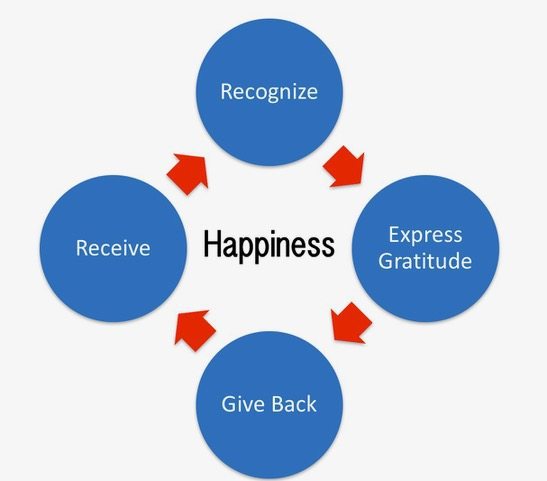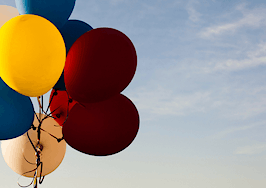This post was last updated Nov. 22, 2021.
Hopefully, the worst of the COVID-19 pandemic is behind us. However, the aftermath in terms of the economy, the people who delayed medical care due to the pandemic, coupled with skyrocketing food and energy prices continue to be sources of anxiety.
In this environment, what does it take to regain your balance and be happy this Thanksgiving?
Several days ago, I had an “aha!” moment that completely reframed my thinking about happiness. It struck me that the route to happiness could be explained in a simple four-step model. This approach can completely transform your life if you choose to implement it.

This process is a continuous loop. It begins with recognizing something positive about your life and then expressing gratitude for it. Next, look for a way to give back or to pay it forward. Giving back triggers receiving, which is others giving back to you.
Step 1: Recognize the positives
There’s a saying that where attention goes, energy flows. The reticular activating system (RAS) determines which incoming stimuli make it from your brainstem into the higher-order thinking centers in your brain.
To illustrate how this works, recall a time you were dining out and someone dropped a tray full of dishes. Your RAS immediately shifted your focus to where the noise originated.
When you’re focused on what’s negative, your RAS will continue to note other negative things that reinforce how negative everything is. In contrast, when you consciously focus on what’s positive, your brain will continue to bring other positive events to the forefront of your attention.
As Beverly Merz, executive editor of the Harvard Women’s Health Watch, wrote: “Winnowing out and focusing on the positive aspects of a situation are key factors in acquiring resilience — the ability to bounce back from bad times — that will help you weather the losses that may occur in the years ahead.”
If you find yourself entangled in negativity, one way to break the cycle is practicing gratitude.
Step 2: Express gratitude
Assume that someone who is texting and driving comes within inches of ramming your car. Your body immediately kicks into a fight or flight state. At this point, you can become angry, or you can express gratitude: “I’m so thankful we weren’t in an accident just then.”
The expression of gratitude will help to rapidly reduce both your adrenaline and blood pressure as opposed to becoming angry, which will send them both sky high.
Because the entire advertising industry is predicated upon your sense of lack, many people today feel they don’t have enough. Here’s an extremely important point a coach on one of my training calls once made: “How can I ask God for more when I don’t appreciate what I already have?”
When you express gratitude, it increases your sense of abundance. This in turn counteracts a sense of lack that so many people struggle with today.
What’s more, expressing gratitude also has a slew of health benefits. According to the Mayo Clinic, “a daily gratitude practice has been shown to significantly increase your happiness — and your physical health. Practicing gratitude improves sleep, boosts immunity and decreases the risk of disease.”
One of the best ways to express gratitude consistently is to keep a gratitude journal. Each day write down at least five things for which you are grateful either in a bound journal, Evernote, or the notes app on your mobile device. Look for little things — a warm bed on a cold night, your favorite food in the pantry, or the stranger who wished you good morning today.
Also, remember to express gratitude to those who give you service throughout the day — the busboy who brings your water to the table, the person who rings up your groceries, or the neighbor who always pulls your trash bins off the street while you’re at work.
Step 3: Give back
The third component of being happy is giving back to others. Giving back to others increases your endorphins, nature’s feel-good neurotransmitter. It makes no difference whether you give money, coach a soccer team, spend time volunteering or do anything that helps another person.
Three important gifts that you can share that also increase endorphin levels are your smile, your laughter and your undivided attention.
Robin Dunbar’s research shows that pain thresholds increase when people watch comedy. Paul Pearsall found that laughing 100 times a day was a powerful force for warding off cancer and heart disease.
In each case, it’s due to the release of endorphins. Endorphins relieve the physical part of the pain while simultaneously reducing anxiety. If you have ever defused a tense or unhappy situation with laughter, you know how potent laughter can be.
Laughter and anger or sadness cannot be experienced simultaneously. Laughter strengthens relationships, enhances teamwork, promotes group cohesiveness and can defuse conflict.
Furthermore, humor is a powerful way to heal resentments, disagreements and hurts while also increasing your emotional resilience. All these benefits add up to not only greater degrees of happiness, but to increased longevity as well.
In addition to your smile and laughter, your undivided attention is one of the other most powerful gifts you can share.
Each morning, identify a child, friend, colleague or perhaps a lonely elderly friend or relative who would benefit from your undivided attention. Spend at least 20 minutes with that person with no outside interruptions.
After doing this for a week, check two things: first, how did you feel about yourself, and second, did someone else do something unexpectedly nice for you?
Step 4: Receive
In their book The Go-Giver, Bob Burg and John David Mann describe “The Five Laws of Stratospheric Success.” Their fifth law is “receptivity,” being willing to receive.
The key to giving is being open to receiving. The authors argue that all the giving in the world won’t bring success or create the results you want, unless you also make yourself willing to receive in like measure. Failure to accept the gifts of others shuts down their ability to receive the benefits of giving to others.
For me, this last law was a huge “aha.” Giving leads to receiving. In fact, the people I know who are the most generous often claim, “The more I try to give away, the more I receive.”
If you want to experience more happiness in your life, spend a week working with this four-step model of happiness and see what happens this holiday season. Happy Thanksgiving!
Bernice Ross, CEO of RealEstateCoach.com, is a national speaker, author and trainer with over 1,000 published articles and two best-selling real estate books. Learn about her training programs at www.RealEstateCoach.com/AgentTraining and
www.RealEstateCoach.com/newagent.













